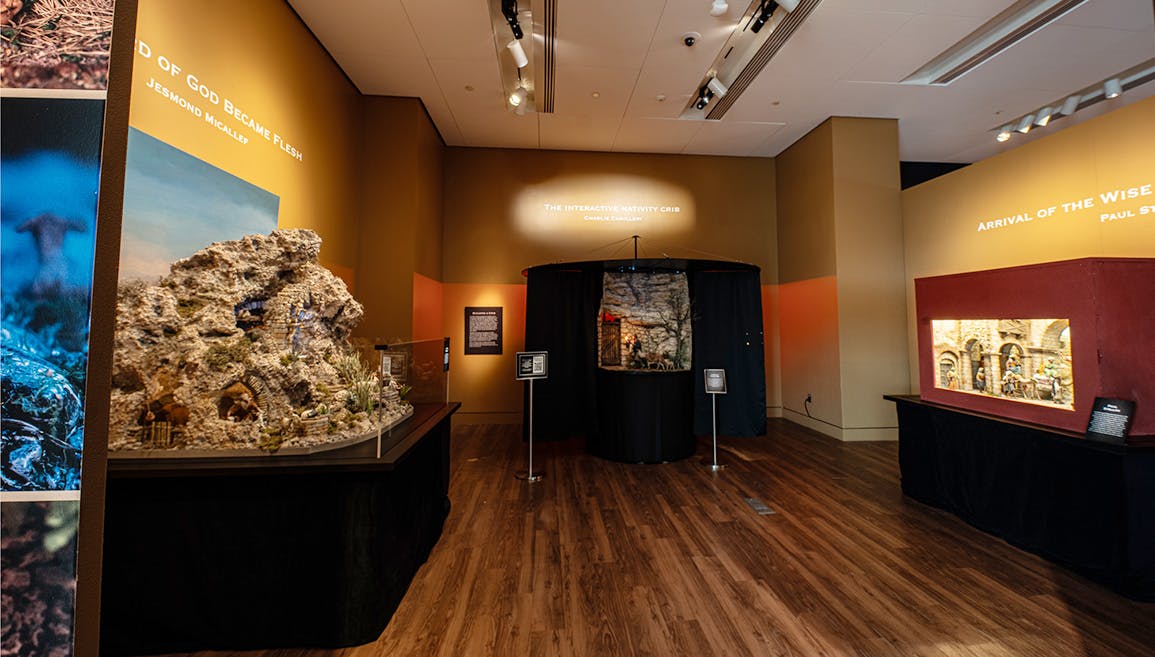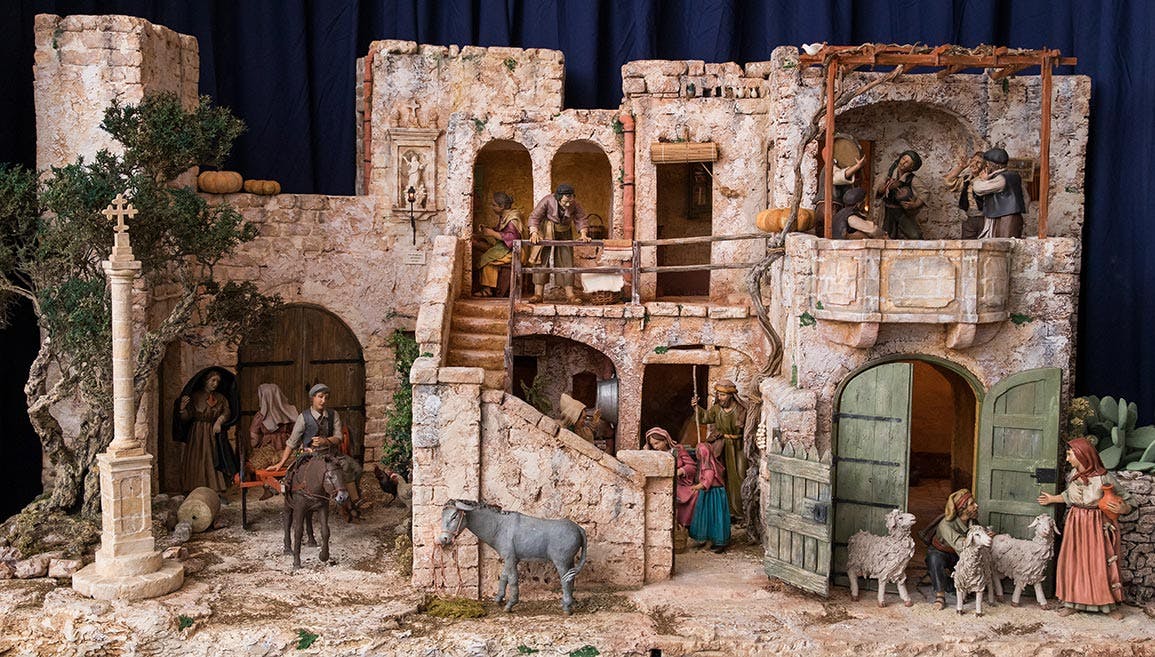O Come, Let Us Adore Him: Revisiting the Nativity Crib Tradition in Malta

It’s Christmas Eve on the tiny island of Malta. A parade of children makes its way down the street singing carols and carrying a statue of the baby Jesus on their shoulders. They pass by local shops selling decorations, baked goods, and tiny figurines of the holy family for display in people’s homes. They continue to the town square where a large Nativity scene has been constructed. Its figures are life-size and the details are exquisite. Following the children’s procession, people gather at the church for midnight mass. Christmas carols are sung, and a child reads the Christmas story from the Bible, welcoming Christmas day with innocence and reverence.
Maltese Christmas traditions like these are centuries old and encouraged each year by the Culture Directorate of Malta to instill a sense of religious tradition in younger generations and bring awareness of Malta’s rich history to the world. Committees and membership groups plan all year for the festivities, devoting vast amounts of time to organizing events and building Nativity scenes (or cribs) for public exhibition.
Nativity cribs are handcrafted scenes of the birth of Jesus. They are called “cribs” after the feeding box used for livestock, now commonly translated as “manger,” in which Jesus is laid according to the Gospel of Luke. They are an important part of Malta’s history, incorporated and adapted from a tradition started in Italy by Saint Francis of Assisi, who staged the first Nativity scene in 1223. It was so popular that by the end of the century, almost every church in Italy had a Nativity scene. The practice reached the shores of Malta by 1617.
Though Saint Francis had used living animals and humans to stage his Nativity, statues of varying sizes soon replaced them. This allowed Nativity cribs to move beyond churches and into the homes of wealthy nobles, who could afford the sets. Those who could not began to build their own, a tradition still vibrant today.
Different styles have influenced the design of the cribs. At first, styles from Naples were popular in Malta, but in the early 1800s, the Sicilian style was introduced and became fashionable. During the nineteenth and early twentieth centuries, crib building flourished, with the style adapting to local aesthetics and traditions. Mechanical elements were added in the mid-1800s, bringing the cribs to life.
Two organizations have been created to promote crib building: the Society for Religious Doctrine, known as M.U.S.E.U.M., in 1907; and the Association of the Friends of the Crib in 1986. The first group emphasizes crib building as part of Christian traditions surrounding Christmas, while the second promotes cribs as a long-standing Maltese tradition.
Some Maltese cribs draw inspiration from the biblical narrative and set the scene of the birth of Jesus in a traditional grotto or cave near Bethlehem, while others draw inspiration from local culture, materials, costumes, architecture, and geological formations. Many artists choose to set the scene in a Maltese farmhouse or village, merging the spiritual story with their physical world. Maltese characters like folk singers, shepherds, lace makers, bread makers, and fishermen are often present. They also typically include a sleeping man who represents people who do not believe in Jesus, a dark-skinned man who represents all people whom Jesus came to help, and a woman wearing a traditional Maltese dress called a għonella.
Originally, materials such as stone, abundant in the Maltese countryside, and coal residue, commonly known as gagazza, were used to create the shape of the crib. Figurines were created from soft clay, plaster, and even candle wax. They are called pasture, from the Italian word pastore, meaning “shepherd,” after the shepherds who first visited Jesus. Finishing elements like grass and twigs were also applied, and later, mechanical elements were added.
Today, crib enthusiasts prefer to use lightweight materials like polystyrene and papier-mâché, but those do not survive well in storage. Therefore, the cribs are often destroyed after Christmas and recreated each year.
In 2020, the Culture Directorate of Malta held a national competition where a jury chose 10 cribs. Those were then displayed here at Museum of the Bible in Washington, DC, where a final winner was chosen by our guests. The winning crib was by artists Adrian Gatt and Raymond Zammit, with figures by Jesmond Micallef. Their crib was titled Malta Fil Presepju (Malta in the Heart of the Nativity Crib) and placed the birth of Jesus in a Maltese house partly demolished during the Second World War. It is a reproduction of a painting by Giuseppe Calì found in the Nativity Altar at the Luqa Parish Church. Around the scene, musicians play Maltese instruments, while a woman wearing a għonella walks with her daughter.

Figure 1: Last year’s winning crib, Malta Fil Presepju (Malta in the Heart of the Nativity Crib), by artists Adrian Gatt and Raymond Zammit, with figures by Jesmond Micallef.
Gatt and Zammit are members of the Għaqda Mużikali Sant’ Andrija of Luqa Malta, a cultural organization that participates in social and religious activities to promote Maltese culture. Cribs built by past members have been featured at the Maltese National Parliament and the Basilica of Saint Paul Outside the Walls in Rome, and now at Museum of the Bible in Washington, DC.
This year, another crib competition was held in Malta, and Museum of the Bible was honored to partner with them once again by exhibiting the top three winners.

Image © Museum of the Bible, 2023. All rights reserved.
The Word of God Became Flesh by Jesmond Micallef
This crib is a traditional representation of the birth of Jesus within a grotto, or cave. The rough rocks surrounding the grotto are indicative of local rocks found on the island of Malta and the nearby island of Gozo. All the elements in this crib were made by the artist Jesmond Micallef, who began drawing figures, birds, and other things as a young child in the 1970s. He honed his skill at a local art school, where he created sculpted terracotta figures for cribs. Since then, his work has been represented in churches across Malta, museums in the United States and Italy, and private collections in Malta, Spain, Austria, and Sicily. Micallef, along with his wife and two daughters, lives and works in Malta.

Figure 3: Micallef’s depiction of Mary and Joseph with the baby Jesus. Image © Museum of the Bible, 2023. All rights reserved.

Image © Museum of the Bible, 2023. All rights reserved.
Arrival of the Wise Men in Bethlehem by Paul Stellini
This crib depicts the moment the three wise men arrive in Bethlehem and see Joseph, Mary, and Jesus. This scene is placed in a viewing window, like a diorama.

Figure 5: Depiction of the wise men on their way to visit the holy family. Image © Museum of the Bible, 2023. All rights reserved.
The figures were created by the artist Hubert Saliba, and the surrounding scene was created by the artist Paul Stellini, who began building cribs with his brother in 1985. He has since broadened his artistic endeavors to include painting, interior design, theater set design, and landscaping. He holds a BFA in painting from the Pietro Vannucci Academy of Fine Arts in Perugia, Italy, a postgraduate certificate in teaching from the University of Malta, and a BFA in interior design from the New York School of Interior Design in New York City. In 2013, he and his friends created the Ghanjnsielem Crib Making Association to support artists of this creative tradition. Stellini, with his wife and two daughters, lives and works on the island of Gozo.

Figure 6: Paul Stellini adding final touches to his crib. Image © Museum of the Bible, 2023. All rights reserved.

Image © Museum of the Bible, 2023. All rights reserved.
The Interactive Nativity Crib by Charlie Camilleri
This is an interactive crib where the viewer assumes the role of a shepherd on a journey to find the baby in the manger.

Figure 8: Open the door and meet this person, who will guide you to finding baby Jesus. Image © Museum of the Bible, 2023. All rights reserved.
This circular crib is made of wood, plastic, resin, metal, papier mâché, and textiles. Everything in the crib, including the figures, was handmade by the artist, Charlie Camilleri, who started his creative career in the early 1990s working in both sculpture and painting. His work expanded to include contemporary mixed media art in papier-mâché, metal, wood, resin, and glass. His work has been featured in exhibitions in Malta, the United States, Belgium, Italy, the United Kingdom, Germany, Canada, and Switzerland. Camilleri lives and works on the island of Gozo teaching sculpture and crib-making at a visual and performing arts school.

Figure 9: Once you go around the crib, you’ll see the intricate detailing of Camilleri’s depiction of the grotto where Jesus was born. Image © Museum of the Bible, 2023. All rights reserved.
Come explore the intricate world of the Maltese Nativity crib in Christmas in Malta: Winners of the 2023 Nativity Crib Competition, now on display through January 7. Learn more about this exhibit here.
By Amy Van Dyke, Lead Curator of Art and Exhibitions


